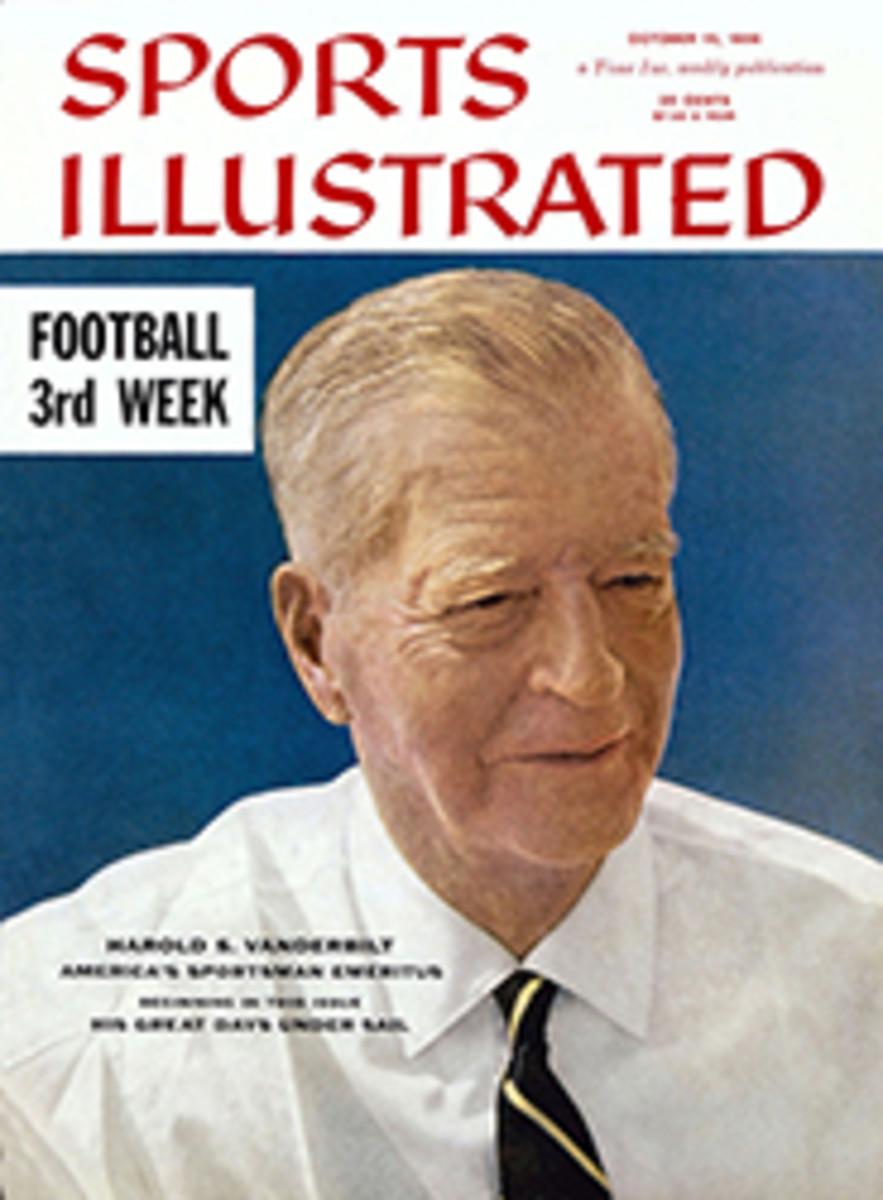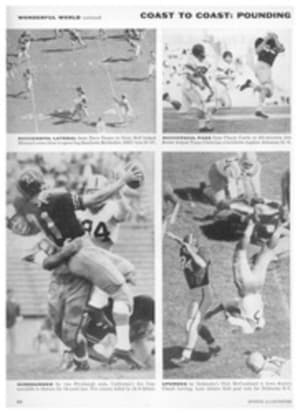
FOOTBALL: THIRD WEEK
MICHIGAN STATE 9
MICHIGAN 0
When Michigan plays archrival Michigan State—as Fritz Crisler, Michigan's athletic director, noted on the eve of the big game—it's civil war. Last Saturday each team brought along its blitzkrieg offense, but the game was fought and won up in the trenches where the linemen wage their savage, static combat. When the head-butting was over, the Michigan State infantry had outlasted Michigan. "It was," said State Coach Duffy Daugherty, raising his Irish tenor over the dressing room bedlam, "the hardest-fought game I've ever seen."
Getting ready for Michigan, Duffy devised a battle plan that was straightforward and simple. "We hope to spread out the defense by splitting our linemen," he said, "and then run up the middle." Duffy had the power for the job—Halfbacks Clarence Peaks and Walt Kowalczyk. To shackle this pair, Michigan Coach Bennie Oosterbaan had his linemen charging mole-low all week long in a slashing converging defense. His penetrating linemen might run into mousetraps, Bennie admitted, but then again they might do some damage. Up in the stadium at Ann Arbor, a sellout crowd of 101,001 ("largest ever to see a sports event in the state," crowed Crisler), huddled under umbrellas and wet newspapers and peered through an intermittent rainstorm in soggy astonishment as Oosterbaan's charging linemen stacked up State's celebrated attack.
Under the stands at half time Duffy often pulls a new offense out of his bag of tricks. Against Michigan he drew up a new defense: a seven-man front with two men frequently dropping out as linebackers. To defend against passes, Duffy deployed his backs in the "Umbrella," an arc formed by two wide halfbacks and two inside safety men.
That did it. Michigan's tiring linemen could not handle the combination of Duffy's new formation and tough reserves. Michigan Fullback John Herrnstein, an 18-year-old sophomore, tried a jump pass early in the third quarter. Instantly State Linebacker Arch Matsos took a step back, stuck up one hand and made a deft interception. Nine plays later State Captain John Matsko riveted his eye on the ball and calmly kicked a field goal from the Michigan 21, the first he had ever tried.
At the start of the fourth quarter, Herrnstein tried again. Running like a Patton tank, he smashed through the State line for five yards and then felt the ball disappear as he was hit by an arm-wrenching tackle. Minutes later Halfback Dennis Mendyk slashed over right tackle for a touchdown and the ball game.
OHIO STATE 32
STANFORD 20
Beautiful, rapierlike passing by John Brodie (12), carved the Ohio State defense as deftly as a surgeon's scalpel, but Stanford, its line riddled by injuries to no less than seven players, could not interrupt the momentum of State's ponderous, crushing attack. Although Brodie passed for 269 yards and two touchdowns, the decision finally rested with Ohio State's brute force and their heavy troops.
ARMY 14
PENN STATE 7
Bob Kyasky (22), here dragged down from behind by Penn State's Sam Valentine (60) after an eight-yard gain, settled comfortably into job as Army's T quarterback, hustling Cadets to two quick first-quarter touchdowns. The converted halfback then turned to defensive heroics, intercepted a vital pass, made a saving tackle on Penn State's brilliant Bruce Gilmore to preserve the fruits of his labor on offense.
HALLELUJAH DAY AT FRANKLIN FIELD
There was hoarse singing in the University of Pennsylvania showers, the first in three years. Beads of happy sweat twinkled on Coach Steve Sebo's forehead as he autographed bits and pieces of goal posts. The chimes atop ivy-clad Irvine Auditorium pealed "Glory, glory, hallelujah!" For Penn had just beaten Dartmouth 14-7. It was Penn's first victory in 20 starts, its first under Coach Sebo, in its first game of official Ivy League competition. Victory had come, at long last, after years of fruitless and futile trampling under the cleats of Notre Dame, Army, Duke, Navy and California.
For Penn, and for Sebo, it looked to be the beginning of a new era. Penn, freed of an absurd schedule, could anticipate sensible competition in its own league. Sebo, who once had coached little Alma College to an undefeated season and later had helped coach Michigan State's famous pony backfield to a Rose Bowl victory, could expect the refurbishing of his reputation.
The season began under poor auspices. Penn State clobbered Penn 34-0. Most Penn students had never seen their team win a football game. Not even the five seniors on the 50-man squad had experienced victory. Before the Dartmouth game the team was tense, grimly silent, almost numb. Penn did not look like a team that was "up."
Nor did it look that way in the opening minutes, when Dartmouth, downing a punt on its own 36-yard line, advanced in six plays to a touchdown and converted. One of the plays was a whistling pass from Quarterback Mike Brown, son of the Cleveland Browns' coach, to End Monte Pascoe for a 48-yard gain. Brown's faking on that play, from Dartmouth's curious V formation, was worthy of one of his papa's quarterbacks. He sneaked over from the one for the touchdown.
The wise men in the press box concluded that this was the way it would be. So did Dartmouth. Coach Bob Black-man, who had no way of knowing the Penn team's great determination, sent in his second team. Whereupon, on the first play after the kickoff, Penn's John Wright went over right guard for a 56-yard run and a first down on Dartmouth's 26. Penn punched over a touchdown in six plays.
The second Penn touchdown, the winner, came on a sustained drive from its 28-yard line, where it picked up a Dartmouth fumble. Penn students could not wait for victory to be official. A minute before the game ended, they had swarmed onto the field en masse and smashed down both goal posts. Referee Albie Booth didn't penalize Penn for the breach. He understood.
TEXAS CHRISTIAN 41
ARKANSAS 6
The remarkable development in this year's TCU football team, which demolished a perfectly respectable Arkansas squad in the TV Game of the Week while opening its defense of the Southwest Conference title, is that the rest of the club has caught up with Jim Swink. The slim star of last year's champions now cheerfully shares top billing with a covey of backs who can do their jobs almost as well as he does his and with a line which makes it look almost easy for all of them.
The scoring tells the story of their offensive balance. The first touchdown came on a pass from Chuck Curtis, the poised quarterback, to Ken Wineburg, the fast and powerful right half, who was ignored in the end zone while Curtis bamboozled Arkansas into looking somewhere else. Wineburg scored the second on a simple sweep around end for 46 yards after the secondary had followed Swink on a fake into the line and Guard Joe Williams had obliterated the corner man. Curtis scored the third on a sneak, setting it up with a 36-yard pass to Swink. Swink got the fourth from a foot out. Buddy Dike, a fine fullback, scored the fifth on two straight trap plays, good for a total of 53 yards. The sixth was scored by a substitute after TCU recovered an Arkansas fumble on the latter's 18-yard line.
Swink is still the lead horse, a sure gainer every time he is called on to carry the ball (in addition to his 36-yard pass completion, he gained 71 yards in 15 carries). According to Coach Abe Martin, one of his greatest boosters, Swink's very presence tightens up the defense and makes the job easier for his teammates.
TENNESSEE 33
DUKE 20
Every week Tennessee looks more like a national football power, and Johnny Majors looks more like an All-America football player.
The hardy, beautifully coached Volunteers exploded time and again from their classic single wing at Durham Saturday to wallop Duke in a drenching downpour. The magnificent Majors was at his tailback post only for the first 19 minutes, He wasn't needed thereafter. In these few minutes, Johnny managed 105 yards in seven twisting, tightroping carries, one pass completion in two tries for 12 more yards. He scored the first two touchdowns on thrilling runs of 17 and 28 yards, set up the third Vol score and then retired as Tennessee spent the rest of the afternoon showing that it has two sub tailbacks—Al Carter and Carroll Young—who are nearly as good as Johnny.
The deception and crunching efficiency of Tennessee's single wing was beautiful. Majors and his successors spun nicely on fullback fakers, rolled out to either side, then cut in behind deadly blocking and picked their way through the secondary—stopping, starting, feinting and just plowing for long gains. The deep reverses, with Wingback Bill Anderson outlegging confused defenders, added variety to the imaginative attack. The Vol guards cleared gaping holes straight ahead for fast-starting Fullback Tommy Bronson. Trap plays worked for good gains up the middle and, altogether, the Vols rolled up 333 yards rushing.
No doubt about it—the Vols proved conclusively that the ancient single wing can still be a murderous instrument in modern football (see page 70).
TWO PHOTOS
PHOTO
HAPPY STEVE SEBO MOPS BROW
THE ELEVEN BEST TO DATE
Georgia Tech
Miami
Michigan State
Michigan
Mississippi
Ohio State
Oklahoma
Southern California
Tennessee
Texas A&M
Texas Christian

